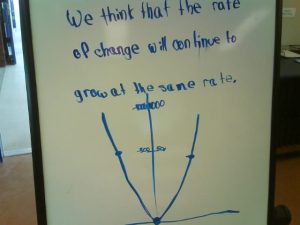- Slope and rate of change mean the same thing.
- If the rate of change remains the same, then we have a line.
- The initial condition is the y intercept.
- If the initial condition is 0, then we have a direct variation.
They like lines; they are comfortable with lines. It is time to take them out of their comfort zone. So here is how it went down:
We had already done some activities on linear relationships like:
- Farenheit vs. Celcius
- cm vs. inches
- km vs. miles
- start height vs. rebound height for a bouncing ball on concrete between 75 and 80 degrees with no wind resistance. (Alright, we didn't control the experiment that much, but they still saw that the ball rebounded to about 70% the original height. Daniel learned that baseballs don't bounce very high when you drop them from 1 meter and the seams mess up the bounce.)
The latest installment was to have them bring in a few circular items and then find the relationship between radius vs. circumference. This led quite nicely into, 'Well, since you have some circles here, you may as well calculate the areas too. Graph those compared to the radius and see what you get."
It was interesting to see how many kids tried to force it into a linear relationship.
Angel recognized that "choosing a bunch of circles with around the same radius doesn't tell us much, huh, Mr. Cox."
"Nope, next time we may want to expand our sample space."
Regardless, by the end of the activity, they understood that sometimes we have relationships that are "curved" or "non-linear." Fareen recognized that we get a "half of a parabola."
So from there we do some work with the side length vs. area of a square. Hey, we may as well start at the beginning, right? But it was the simplicity of the exercise that produced the magic that I never saw in 10 years of teaching high school kids the same thing.
"Hey, Mr. Cox, it isn't a line because the slopes don't stay the same."
"Yeah, so what?"
"Well the areas increase by 3, then 5 then 7. But the increases all increase by 2."
"Okay, so what does that mean?"
"The rate of change has a rate of change."

At this point I get goosebumps.
This is when Abel, asks: "What will happen if we cube x? What happens to the rate of change then?"
Couldn't pass this one up, so we drew up a chart and did it. The kids concluded that for a cubic: the rate of change of the rate of change has a rate of change. Oh, and the number of times we have to check the rate of change tells us what the exponent is.

Moral of the story: Don't assume that your lesson objective is the right one.
or, Sometimes it is better to follow the herd of cats.
next step...derivatives! (just kidding, but what a great discussion!)
ReplyDelete